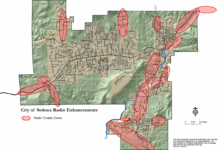It’s like having a party where no one comes. For the fourth and final time this year the Sedona City Council held a public hearing for proposed changes to its Developmental Impact Fees — as required by state law.
And for the fourth time there was no public input. But this time it received approval during the Sedona City Council’s June 26 meeting. The fees will become effective Sept. 9.
According to a city report, DIFs are one-time charges applied to new development in order that new growth will pay its fair share of infrastructure improvements needed to provide municipal services, and to ensure that existing residents are not unduly burdened to pay for improvements and services needed to accommodate new development.
The state requires that these fees be updated every five years. State statute requires the city follows a series of steps to develop and implement new DIFs. These steps include a minimum of 225 days and include public hearings and public comment periods. This meeting was the second of four that will be scheduled when the fees become effective.
In her staff report, Assistant City Manager Karen Osburn said the categories under consideration for assessment of these funds are streets, police and parks. While the current DIF schedule also assesses fees for drainage and general government, she said these categories are proposed to be removed in the update.
Although drainage is a permitted category, the city’s current drainage issues are existing and only an extremely small portion of the costs of improvements could reasonably be attributable to new growth. As a result, new development should not be required to contribute financially to solving the existing drainage issues. The current fee structure charges a flat DIF for single-family homes as well as one for multi-family. Under the proposed updated plan it will be more of a sliding scale depending upon size of the home.
“The thought process behind this graduated scale of fees, based on unit size, was to help promote some of the unit types and sizes that we don’t have as many of in the community and would lend itself better to greater affordability and workforce housing,” Osburn said in March.
In a report by city consultant Tischler-Bise, it breaks down the projected needs and costs for streets, police and parks over the next decade to keep up with demand of a growing population in which the DIF could be used. These include:
- Parks and Recreation
Land: four acres at a cost of $604,000
Improvements: $770,00
Facilities: 1,400 square feet for $174,000
- Police
Vehicles: Two for $110,000
Facilities: 1,000 square feet for $245,000
Communications equipment: $135,000
- Streets
Arterial street improvements: $2.3 million
Other street improvements: $150,000
“This is one mechanism that allows you to have development pay for itself,” Tischler-Bise’s Ben Griffin said in February in regard to the DIFs. “You need infrastructure capacity to continue growing. This is one way to ensure that you have that capacity. By having these components in place it allows you to say, ‘These are the components we think we need as a community to continue growing.’”






















